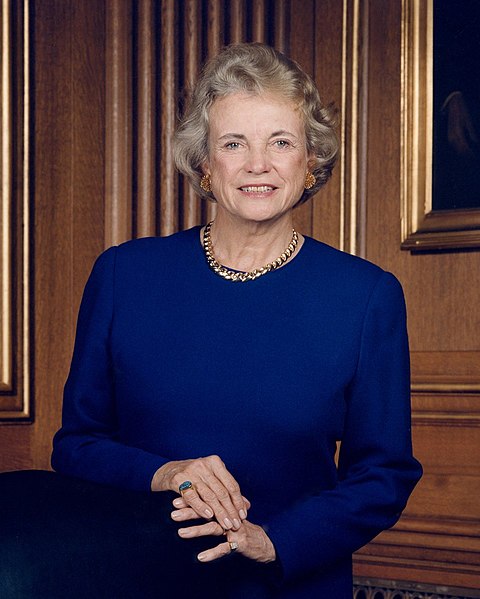Justice Sandra Day O’Connor, the first woman to serve on the U.S. Supreme Court, died today at age 93.
While the Freedom From Religion Foundation did not always agree with her rulings, we recognize that she understood the First Amendment in a way the Roberts Court has abandoned and honor her for that. Most of the current justices likewise would be well advised to study O’Connor’s commitment to a nonpartisan judiciary.
Supreme Court observer Linda Greenhouse reminds us in her New York Times obituary today: “Although William H. Rehnquist, her Stanford Law School classmate, served as chief justice couduring much of her tenure, the Supreme Court during that crucial period was often called the O’Connor Court, and Justice O’Connor was referred to, accurately, as the most powerful woman in America.” Greenhouse notes that “the law regarding affirmative action, abortion, voting rights, religion, federalism, sex discrimination and other hot-button subjects was basically what Sandra Day O’Connor thought it should be.”
Her abrupt departure in 2006 to nurse her ailing husband tipped the court from a 5-4 balance that was more or less moderate to a 5-4 balance that was dependably reactionary. For the Freedom From Religion Foundation, that departure couldn’t have been more poorly timed, as our challenge of faith-based offices in the White House and at the Cabinet level was wending its way through the courts. FFRF appealed to the U.S. 7th Circuit Court of Appeals to uphold our standing to sue in March 2005. O’Connor announced she would depart that July. A panel of the 7th Circuit in January 2006 upheld our right. But the die was cast as O’Connor was replaced by Samuel Alito. The Bush Administration appealed to the high court, which ruled 5-4 against FFRF in 2007.
Near the end of her time on the court, O’Connor directly questioned the wisdom of those attacking the separation between state and church. She wrote in a concurrence, “Those who would renegotiate the boundaries between church and state must therefore answer a difficult question: Why would we trade a system that has served us so well for one that has served others so poorly?” O’Connor had the vision to see how granting favored legal treatment for the majority religion was self-defeating, and had the courage to call out her colleagues on this folly.
In the same opinion, O’Connor eloquently articulated the importance of the First Amendment’s religion clauses: “Together with the other First Amendment guarantees — of free speech, a free press, and the rights to assemble and petition — the Religion Clauses were designed to safeguard the freedom of conscience and belief that those immigrants had sought. They embody an idea that was once considered radical: Free people are entitled to free and diverse thoughts, which government ought neither to constrain nor to direct.” She went on to clarify that this crucial protection includes not only the freedom of religion, but also the freedom from government-imposed religion: “The Religion Clauses … protect adherents of all religions, as well as those who believe in no religion at all.”
Just a few years after joining the Supreme Court in 1981 as a Reagan appointee, O’Connor brought clarity to how federal courts handle Establishment Clause cases by introducing the so-called “endorsement” test: “Endorsement [by the government of a particular religion] sends a message to nonadherents that they are outsiders, not full members of the political community, and an accompanying message to adherents that they are insiders, favored members of the political community. Disapproval sends the opposite message. . . . The Establishment Clause prohibits government from making adherence to a religion relevant in any way to a person’s standing in the political community.”
This simple test provided straightforward guidance to judges, litigants, and government officials for decades. It was oft-quoted and cited in legal briefs and complaint letters by the Freedom From Religion Foundation and in opinions by other judges upholding the Establishment Clause. If a government action signaled endorsement of a particular religious belief, or of religion over nonreligion, it ran afoul of the Establishment Clause. Sadly, this test was built into the existing “Lemon” Test, which the current court recently eliminated, effectively undoing much of O’Connor’s work and restoring the confusion and injustice she had helped to alleviate.
In the years that followed, O’Connor often sided with other conservative justices, compromising on the values described above and tarnishing her own legacy somewhat. But she also stood up to the likes of Justices Rehnquist, Scalia and Thomas in cases such as in the 2000 Santa Fe case, holding that public school loudspeaker prayers violated the Establishment clause, or in the 1987 Aguillard case, holding that teaching creationism in public schools was unconstitutional.
Even while mourning her departure from the highest court, FFRF admired Sandra Day O’Connor’s subsequent campaign for blue-ribbon-appointed state Supreme Courts and against elected high courts.
After retiring from the high court, O’Connor spoke presciently, along with Justice Ruth Bader Ginsburg, about the danger of extremists influencing the judiciary, and of “naked partisan reasoning.”
“Sandra Day O’Connor earned her spot in history as not only a strong legal mind, but also a genuine, if inconsistent, advocate for the rights of nonbelievers and others who did not share her personal beliefs,” comments FFRF Co-President Annie Laurie Gaylor. “Justice O’Connor understood the importance of keeping the government secular. Our fundamental freedom of conscience is now weaker since O’Connor’s successors have declined to follow her lead in protecting the framers’ vision of religious freedom.”
The Freedom From Religion Foundation is a national nonprofit organization with more than 40,000 members across the country. Our purposes are to protect the constitutional principle of separation between state and church, and to educate the public on matters relating to nontheism.
If you are an FFRF member, sign into your account here and then update your email subscriptions here.
To become an FFRF member, click here. To learn more about FFRF, request information here.


